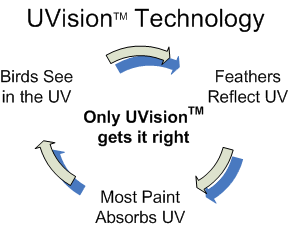|
Learn about the Science of UVision
UVision 1, 2, 3... |
 |
1. Birds can see UV, but humans can't.
Humans are trichromatic, meaning they see color as a mixture of three primary colors: red, green, and blue. Most other mammals are dichromatic and have only two primary colors, leaving them less able than humans to distinguish color differences. However, birds and fish are tetrachromatic - they have four primary colors. This gives them the ability to perceive color differences that humans cannot see. Further, this fourth color is in the ultraviolet wavelengths, which is outside the range that humans can see, but still a significant component of natural sunlight.
2. Many types of bird feathers reflect UV.
The light reflection of birds has been studied extensively. UV photography has shown that UV light reflection is common in nature. There are colors and patterns in some animals and plants that are invisible to humans because they involve only the UV component of sunlight. For example, in a certain species of bird called a Blue Tit, males and females look identical to humans. However, when pictured using UV photography, which converts UV into a color that humans can see, it is apparent that males and females are quite different. Twilight Labs has studied the UV reflection of many waterfowl species using special cameras that are sensitive to UV and analytical instruments that provide detailed reflectance information for very narrow bands of wavelength. Twilight Labs has found that most waterfowl have several areas with moderate to bright UV reflection. Snow geese are very reflective, as are the white cheeks on a Canada goose and the gray stripes down a mallard's back.
3. Color technology for paints and plastics are based on the color vision of humans, not birds.
Since UV light is invisible to humans, there has never been any reason for paints or plastics to have any UV reflection. For example, white is the color humans perceive when all wavelengths of visible light are reflected. The most common white pigment used in paints and plastics is titanium dioxide, which reflects all wavelengths of light except for UV, which it actually absorbs. This doesn't matter to humans, but to a bird the object will not look the same as a white feather.
We can't really understand what the tetrachromatic color is to a bird, but we can understand that decoys which absorb UV will look different to a bird. We simply make a coating that matches the reflection of feathers and adds more realism to your decoys.
|